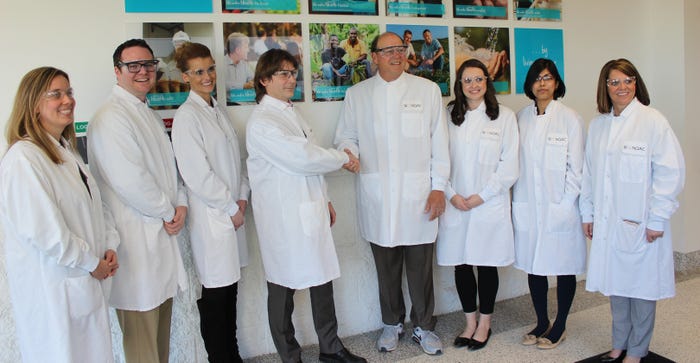
COOPERATIVE SPIRIT: Ohio Department of Agriculture representatives recently toured the Nestlé Quality Assurance Center to learn more about the center’s capabilities.
The quality of the food we all eat might start on the farm, but careful testing helps keep food wholesome as it is processed, packaged, transported and stored. As one of the world’s largest food testing facilities, the Nestlé Quality Assurance Center in Dublin, Ohio, is an industry leader in quality control. The center performs more than 150 different analyses to test food products, packaging and processing facilities.
“You have to be perfect in food safety, it’s non-negotiable," says Fabien Robert, NQAC director.
The Dublin NQAC is the lead quality assurance facility for all Nestlé businesses in the Americas, and it also provides testing for other companies that don’t have access to testing facilities of their own. “We believe food safety should not be competitive,” Robert explains.
The Ohio Department of Agriculture has recently started working with NQAC to find ways to collaborate on product testing. ODA does some similar food quality testing at the department’s lab in Reynoldsburg, Ohio, explains ODA Director David Daniels. By partnering with NQAC, ODA can provide more efficient testing in some areas and offer expertise in others. “It’s a perfect example of government working with private industry to provide a safe healthy product for people,” Daniels says.
Jared Parko, ODA deputy director, explains that ODA might run certain tests only four times a year, so running those tests is not very efficient. If NQAC runs those tests routinely, it makes sense to divert that testing to the NQAC facility. At the same time, the ODA lab has the capability to do whole genome sequencing and other analyses that NQAC doesn’t, Robert says. “It’s clearly an opportunity.” Both ODA and NQAC are working to protect consumers, he adds. “We all have the same goal here.”
One million tests
In all, NQAC performs more than 1 million tests per year. The microbiology department focuses on detection of disease-causing bacteria such as E. coli, salmonella and listeria. Part of the process involves creating favorable growing conditions for those pathogens with ideal temperatures and nutrients, explains Brittany Pace, NQAC microbiology manager. The goal is to identify the presence of pathogens, not the quantity, she says. “Is it there or is it not?” If a pathogen doesn’t reproduce under ideal conditions, they know it’s not present.
Microbiologists also test for molds, yeasts and bacteria that indicate spoilage or hygiene problems. And they can do specialized serotyping to identify variations within species of microorganisms. This can help processors trace the source of the problem, Pace adds.
The facilities themselves are designed to maintain the integrity of the test samples, and to prevent cross-contamination. For instance, pressure differentials between rooms limit airflow into test areas when doors are opened. As employees move through the department, they follow procedures similar to those farmers use in bio-secure livestock facilities. They change into clean lab coats before entering, and then put on shoe covers as they cross over a bench from the “dirty” side to the “clean” side. As they leave, they take off the shoe covers and lab coats to avoid carrying any microbes out of the lab.
The facility’s chemistry department has another array of tests to evaluate food safety and quality. For instance, they can test for residues from pesticides and veterinary drugs as well as contamination from mycotoxins, allergens, heavy metals and radioactivity. They also evaluate foods for nutritional components such as vitamins, minerals, proteins, sugars and fatty acid profiles. This information is necessary for accurate product labels. They even retest products after storage to make sure the nutritional analysis listed on a label is still accurate at the end of a product’s shelf life.
Measuring authenticity
Another important series of tests evaluates the authenticity of products. For instance, if something is labeled as apple juice, tests can confirm that the juice is not from another fruit or modified with added sugars. The NQAC can also test meat to determine whether the species matches the labeling. For instance, if a sample of ground meat came from a giraffe, the test profile would show that, Robert explains. That test would come in handy if a giraffe went missing from the zoo, he jokes. But in all seriousness, the global nature of the food industry today makes such tests important to give consumers transparency about their food. “We can check what we claim is indeed what we say,” Robert says.
Besides testing prepared food products and food ingredients, NQAC conducts tests on swabs taken from manufacturing facilities to check for microbes or other contaminants. Swab tests can also identify allergens in manufacturing facilities.
NQAC works with a variety of customers to provide confidential quality assurance testing. Customers can request specific tests if they’re concerned about a particular issue or the NQAC staff will work with them to recommend a testing regimen for their situation, Robert says.
Nestlé is the largest food and beverage company in the world, and 97% of American households consume at least one of the company’s products. Nestlé makes quality assurance a priority, but it is just as important to smaller food processors, even local food producers, Robert notes. “You have to ensure what you sell is safe.”
About the Author(s)
You May Also Like




